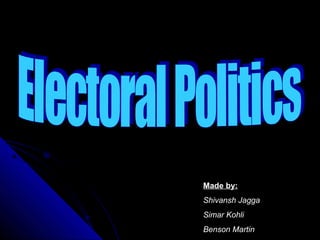
Electoral politics- Shivansh Jagga, INDIA
- 1. Made by: Shivansh Jagga Simar Kohli Benson Martin
- 2. What are Elections ?What are Elections ? Elections’ is the mechanism by which the people can choose their representatives at regular intervals of time and change them if they wish to do so. Elections play an important part in our lives because in it the voters can make many choices:- 1) They choose who’ll make laws for them. 2) They can choose who will form the government and take major decisions for them. 3) They can choose the parties whose policies will guide the government.
- 3. What are Democratic Elections ?What are Democratic Elections ? The conditions of a democratic elections are:- 1) Everyone should have one vote and every vote should have equal value. 2) Parties and candidates should be free to contest elections and offer a choice to the voters. 3) Elections should be held at regular intervals. 4) The candidate preferred by the people should get elected. 5) They should be held in a free and fair manner where people currently in power have a fair chance of losing.
- 4. The LegislatureThe Legislature The Parliament Rajya Sabha (Council of States) Lok Sabha (House of the People)
- 5. Rajya Sabha (Council of States)Rajya Sabha (Council of States) •The Upper House
- 6. The Upper HouseThe Upper House Rajya Sabha (Council of States) not more than 250 members 12 are nominated by the President of India the rest are indirectly elected by state Legislative Assemblies The Council of States can not be dissolved members have terms of 6 years 1/3 members retire at end of every 2nd year
- 7. Lok SabhaLok Sabha (House of the People) The Lower House
- 8. Lower HouseLower House Lok Sabha (House of the People) 545 members 2 are appointed by the President of India the rest are directly elected from single- member districts 5-year terms unless dissolved Lok Sabha elects its presiding officer.
- 9. Electoral ConstituenciesElectoral Constituencies Our country is divided into different areas for purposes of elections. These are called electoral constituencies. For Lok Sabha elections the country is divided into 543 constituencies. The representatives elected from each constituency is called a member of parliament. Reserved ConstituenciesReserved Constituencies The Constitution makers worried that weaker sections may not stand a good chance to get elected. They may not have the required resources, education and contacts to win the elections. So they thought of a special system of reserved constituencies for the Scheduled Caste and the Scheduled Tribe.
- 11. In a democratic election the list of those who are eligible to vote is prepared much before the elections and given to everyone. This list is officially called the Electoral Roll and is commonly known as The Voters List. This is an important step as it is a democratic election: everyone should get an equal opportunity to vote their representatives. Why is the Voters List necessary ?Why is the Voters List necessary ?
- 12. Election CampaignElection Campaign In our country such campaigns take place for a two week period between the announcement of the final list of candidates and the date of polling. During this period the candidates contact their voters, political leaders, address election meetings and political parties to mobilize their supporters.
- 13. How is polling conducted in India ?How is polling conducted in India ? Now a days electronic voting machines are used to record votes. The machines shows the names of the candidates and the party symbols. Independent Candidates too have their own symbols, allotted by election officials. The voter just has to press the button against the symbol to whom they want to give their vote.
- 14. Vote Shares of 3 different political parties.
- 15. Who can be nominated to stand inWho can be nominated to stand in Elections ?Elections ? The conditions to stand in the elections are :- A candidate must be a minimum of 25 years of age to contest. There are some restrictions on criminals. Political parties must nominate their candidates who get the party symbol and support.